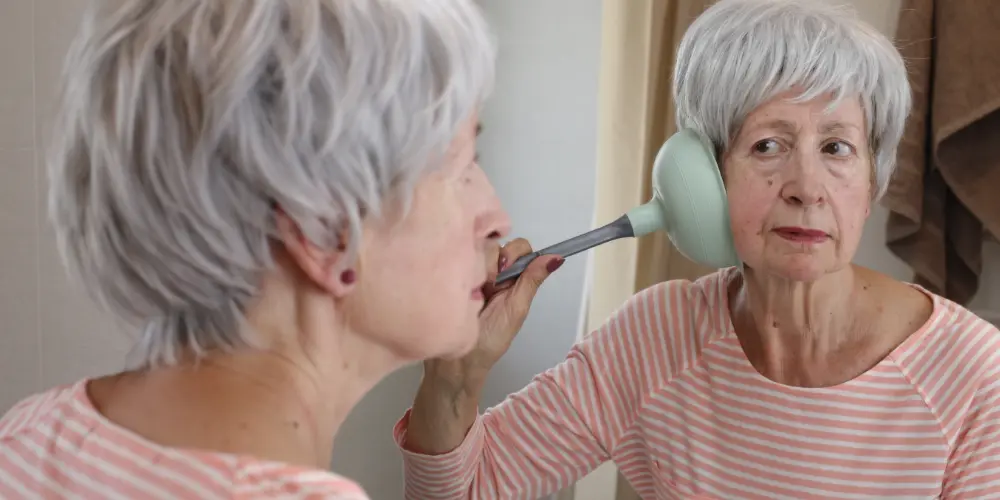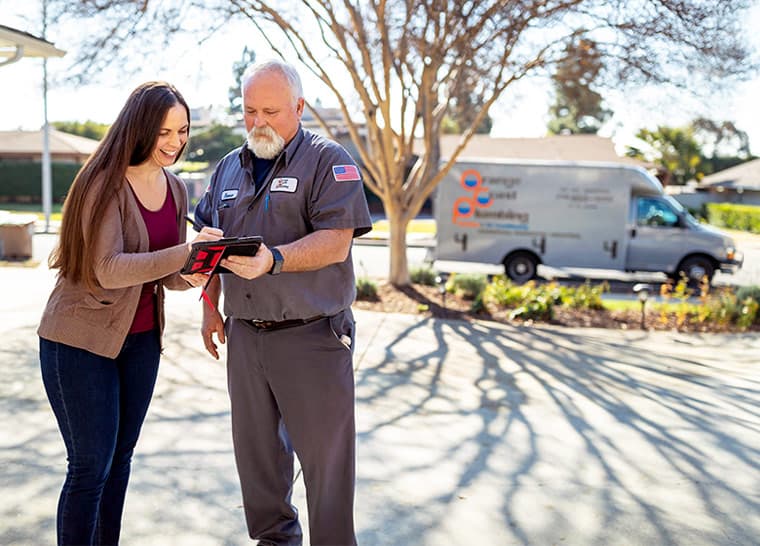What are you going to do in a pinch?
You’ve learned basic first aid for medical emergencies. By the same token, you should master a few DIY plumbing fixes for common household emergencies. With a solid DIY repair, you may not even need the plumber! Plus, do you want to call a professional every time Junior stuffs too much paper down the John? It adds up.
So grab a chair, relax no matter what the emergency (except gas — get the heck out of there), and let’s review the most valuable plumbing repairs you can accomplish in an afternoon. Maybe. Some of these repairs are for the handy — and the brave — but don’t worry, we’ll guide you with clear, step-by-step instructions.
Clearing a Clogged Bathroom Drain
When the water in your sinks, shower, or tub isn’t draining well, you may have a hair and soap scum clog or other debris lodged in the drainpipe. Here are some things to try before calling for help:
- Drain Stick: These are slender, flexible plastic tools with barbs along their length to catch and pull out hair, food particles, and other forms of debris. Simple to use, affordable, and highly effective for minor clogs, they’re a first line of defense for keeping your drains clear. Insert a drain stick into the drain and rotate it to catch hair and debris. Carefully pull it out and dispose of the gunk in a waste basket.
- Non-Chemical Cleaning Agents: Boil a pot of water and pour it down the drain to dissolve soap scum. Follow up with baking soda and white vinegar, wait 15 minutes, and rinse with hot water to clear any remaining buildup.
- Plunger: If the clog persists, use a cup plunger (NOT a toilet plunger). Place it over the drain to create a seal, and give it a few firm thrusts and pulls to dislodge the clog. You may have to run the water before plunging to get the seal.
- P-Trap Inspection: Place a bucket under the sink, remove the P-trap (the curved pipe), and clean out the blockage there. Reattach the P-trap and run water to test the flow.
- Snake Auger: Also known as a plumbing auger or drain snake, a snake auger is a flexible cable with an auger head that can break through blockages in your pipes. Insert it into the drain and work it back and forth while turning the handle until you feel resistance. This means you’ve reached the clog.
- Regular Maintenance: A drain cover can prevent future clogs by catching hair and debris. Also, periodically clean your drain with hot water or a baking soda and vinegar mix.
Clearing a Clogged Kitchen Drain
Kitchen sinks develop clogs from food scraps, grease, and soap deposits, leading to poor drainage and unpleasant odors. Tackle kitchen clogs with the following DIY steps:
- Hot Water Flush: Pour boiling water down the drain to melt away any grease or oily substances that might have hardened.
- Non-Chemical Cleaning Agents: Mix a half-cup of baking soda with a half-cup of white vinegar and promptly pour the fizzing mixture down the clogged drain. Wait about 15 minutes for the non-toxic chemical reaction to break down the grime, then rinse with boiling water.
- Enzymatic Cleaner: If you prefer an eco-friendly alternative over chemical cleaners, use a non-destructive enzymatic drain cleaner designed for kitchen sinks. Follow the manufacturer’s instructions.
- Plunger: For more stubborn clogs, apply a sink plunger (which is different from a toilet plunger). Fill the sink partially with water to cover the plunger’s cup, position it over the drain, and push down and pull up vigorously to dislodge the clog. If you have a double sink, you may have to seal one drain plug or wet rag while plunging the other.
- Garbage Disposal Clogs: Your garbage disposal has a reset button at its base. Press it to reset a jammed disposal. You can also reach in with pliers or tongs to pull out food or debris, taking care not to damage the blades. For persistent jams and clogs, you may need a garbage disposal wrench, available at any hardware store.
- Drain Snake: Use a plumbing snake (also called an auger) for the toughest clogs. Insert it into the drain and turn it until you feel resistance. Carefully remove the snake while twisting it to dislodge and extract the clog.
- P-Trap Check: If plunging and snaking don’t work, place a bucket beneath the P-trap under the sink to catch water and debris. Unscrew the connectors on the P-trap, remove it, clean out any obstruction, and put everything back in place.
- Preventive Measures: Avoid disposing of grease, coffee grounds, and hard-to-grind food scraps in the sink. Consider installing a drain screen to catch solid particles, and regularly clean your drain with a flush of hot water.
Fixing a Running Toilet
A running toilet is annoying and potentially expensive. Here’s how you can fix it:
- Inspect the Flapper: Remove the toilet tank lid and check the flapper for damage, warping, or improper seal. As a short-term solution, you can soften it with Vasoline.
- Replace the Flapper: If it’s damaged, purchase a compatible replacement from a hardware store and install it according to the manufacturer’s instructions.
- Test the Float: Gently lift the float arm when the water is running to see if it stops. If the water stops, adjust the float to the correct level.
- Adjust the Fill Tube: Ensure the fill tube is above the water line and securely attached. The tank won’t fill properly if it’s too low, causing a constant run.
- Check the Chain Length: A flapper chain that’s too tight or long can prevent the flapper from sealing. Adjust the chain to the correct length.
- Check for Leaks Using Dye: Place a few drops of food coloring in the tank and wait a few minutes. If the color seeps into the bowl, there’s a leak, possibly due to a bad seal with the flapper.
- Adjust or Replace the Fill Valve: If the problem persists, the fill valve may need to be adjusted or replaced entirely. This involves shutting off the water supply and replacing the old valve with a new one.
- Call a Plumber: If all else fails, call a professional plumber who can diagnose and fix any underlying issues. A plumber can also offer suggestions for improving your toilet’s efficiency to save water and money in the long run.
Fixing a Toilet Leaking at the Base
Water around the base of your toilet can indicate a leak between the toilet and the drain flange. If you’re handy, you can attempt several DIY fixes:
- Tighten the Closet Bolts: Sometimes, the bolts securing the toilet to the floor must be tightened. Be careful not to overtighten them and crack the porcelain.
- Replace the Wax Ring: The wax ring that seals the toilet to the drain pipe will need to be replaced if it’s old or degraded. Remove the toilet and install a new wax ring, ensuring it’s centered and firmly seated to create a good seal.
- Inspect the Flange: If the leak persists, inspect the flange for damage (the flange connects the toilet to the sewer pipe). You’ll need to replace a cracked flange before reinstalling the toilet.
- Apply Caulk around the Base: After reinstalling the toilet with new bolts and a wax ring, apply a caulk line around the base for additional leak protection.
- Fixes with Teflon Tape: A leak can also occur at the water supply tube connection. Turn off the water supply, disconnect the tube, and wrap Teflon tape around the threaded male end on the shut-off valve. Replace any worn washers. Reattach the supply tube securely.
Unclogging a Toilet
Always wear gloves and maintain proper hygiene when dealing with toilet clogs.
- Prepare the Area: Place old towels around the toilet’s base to absorb potential spills.
- Use a Plunger: Start with a flange plunger for toilets. Insert it into the bowl and ensure a tight seal around the drain hole. Push down and pull up steadily without breaking the seal. This motion may dislodge the blockage.
- Dish Soap and Hot Water: Squirt a generous amount of dish soap into the bowl, followed by a bucket of hot (but not boiling) water. The soap can lubricate the clog, while the hot water softens it for easier plunging.
- Baking Soda and Vinegar: For another approach, pour one cup of baking soda and two cups of vinegar into the toilet. Wait several minutes as the mixture fizzes, and then add hot water. After waiting an additional 30 minutes, try plunging again.
- Apply a Toilet Auger: If plunging doesn’t work, use a toilet auger — a specialized tool to navigate the toilet curves (different from a drain auger). Reel out the auger until it meets resistance, then gently crank the handle to break through the clog. Always crank clockwise to avoid damaging the bowl with the auger wire.
- Chemical Drain Cleaners: Try a chemical drain cleaner suitable for toilets as a last resort. Carefully follow the instructions since these chemicals can damage plumbing if misused.
- Avoid Persistent DIY: If the clog has not cleared after several attempts, it might be too solid or deep for home remedies. Refrain from repeated aggressive plunging or augering and call a professional plumber.
Fixing a Leaky Faucet
Here are the basic steps to address the most common types of faucet leaks:
- Turn off the Water Supply: Shut off the water supply to the faucet. Look under the sink for the shut-off valves and turn the knobs clockwise.
- Plug the Drain: Place a stopper or cloth over the drain to prevent any dropped parts from going down the drain while you work on the faucet.
- Identify Faucet Type: Determine if the faucet is a compression faucet, which has two handles for hot and cold water, or if it’s a ball, cartridge, or ceramic-disk faucet, which usually has a single handle.
- Disassemble Faucet: For compression faucets, remove each handle. Remove the handle and the faucet’s cap and collar for other types, then find the valve system to disassemble.
- Inspect for Damage: Inspect for worn rubber washers, O-rings, seals, or cartridges that need replacement. Take the old parts to the store to find exact matches.
- Replace Worn Parts: Install new washers, O-rings, seals, or a new cartridge as needed, ensuring they fit snugly and are properly aligned.
- Reassemble Faucet: Put the faucet back together. If it’s a compression faucet, tighten the packing nut and replace the handles. For other types, reassemble the valve system and replace any rings or parts in the reverse order they were removed.
- Turn on the Water Supply: Slowly turn the water supply back on and check the faucet for leaks. Make any necessary adjustments to ensure a water-tight seal.
- Test the Faucet: Run hot and cold water to ensure everything works correctly and the leak is fixed.
Repairing Minor Leaks
Minor leaks often occur due to aging materials or loose connections. These are some areas and fixtures to check:
- Under Sink Connections: Examine the pipe connections under sinks for moisture or drips. Tighten any loose fittings and replace worn-out washers or gaskets.
- Toilet Base: Water around the toilet’s base may indicate a faulty wax seal. Remove the toilet and replace the wax ring. Securely reconnect the toilet to the flange.
- Showerheads and Taps: Check for drips or a steady stream when the showerhead or taps are turned off. Unscrew the showerhead or tap, clean any sediment, and apply plumber’s tape before reattaching. Replace any defective rubber washers or O-rings.
- Pipe Joints: Inspect visible pipe joints for leaks or rust. Tighten them, but don’t over-tighten. You can also apply epoxy putty over small leaks as a temporary fix.
- Hose Bibs: Outside faucets or hose bibs can develop leaks. Check the rubber washer inside the spigot and replace it if worn. Also, ensure the hose bib is securely attached to the pipe.
- Appliance Hoses: Washing machine and dishwasher hoses can wear out over time. Inspect them for blisters, cracks, or wet spots. Replace any damaged hoses with new, high-quality ones.
- Water Heater: Look for moisture or water pooling around your water heater, which may suggest a leak or pressure build-up. Check the pressure relief valve and the tank itself for signs of leakage.
When to Call a Professional
In many situations, it’s best to call a professional plumber. These include:
- Major Pipe Leaks or Bursts: These require immediate professional attention. Plumbers will shut off the main water supply and repair or replace the damaged pipes.
- Sewer Line Backups: Symptoms include multiple drain clogs, foul sewer odors, gurgling toilets, and water pooling around basement floor drains. A licensed plumber should address these to prevent health hazards and property damage.
- Gas Line Issues: If you suspect a gas leak (sulfur-like smell or hissing sounds near gas lines), evacuate immediately and contact emergency services, followed by a professional plumber with expertise in gas lines.
- Complex Plumbing Installations: Professional plumbers have experience and tools to handle installations demanding strict adherence to building codes, such as new water lines, tankless water heaters, etc.
Maintenance Tips
Prevention is key to maintaining your plumbing system and avoiding many common problems.
- Regular Maintenance: Regularly clean drains to ensure they’re debris-free. Always fix leaks as soon as you spot them.
- Careful Disposal: Avoid putting grease, oils, or solid objects down sinks or toilets, as they can solidify and block piping. Always dispose of these materials properly.
- Annual Inspections: Schedule annual inspections with a licensed plumber to detect any potential issues early on, ensuring the longevity and reliability of your plumbing system.
FAQs: DIY Plumbing Repairs
Q: Can I use chemical drain cleaners to unclog drains?
A: While chemical drain cleaners can be effective, they may also damage your pipes over time. We recommend trying mechanical methods like plunging or snaking first.
Q: Is using a chemical drain cleaner safe if I have a septic system?
A: Chemical drain cleaners can harm the beneficial bacteria in your septic system. Opt for more natural methods, or call a professional plumber.
Q: Are there any regular maintenance tasks I can perform to extend the life of my fixtures?
A: Regularly cleaning aerators on faucets, checking toilets for silent leaks, and inspecting the anode rod in your water heater can prevent problems and extend the life of these fixtures.
Q: Can DIY plumbing repair lead to warranty issues?
A: DIY repairs can void warranties if manufacturers require professional servicing. Always check warranty terms before proceeding with DIY repairs.
Q: How often should I replace the hoses on appliances like washing machines?
A: Most manufacturers recommend replacing washing machine hoses every 3-5 years. Regular inspections can also help spot potential issues.
Q: Is there a good way to test for toilet tank leaks?
A: Yes, placing a few drops of food coloring in the toilet tank and waiting without flushing for 30 minutes can reveal leaks if the color appears in the bowl.
Q: Do regulations require some plumbing tasks to be done by licensed professionals?
A: Taks like altering home plumbing systems, installing new lines, or working on gas pipes, require a licensed professional to meet regulations and ensure safety.
Q: How can I keep my drains clear without using harsh chemicals?
A: Mix baking soda and vinegar followed by hot water to maintain clean drains. Mesh drain strainers also help prevent debris from causing clogs.


